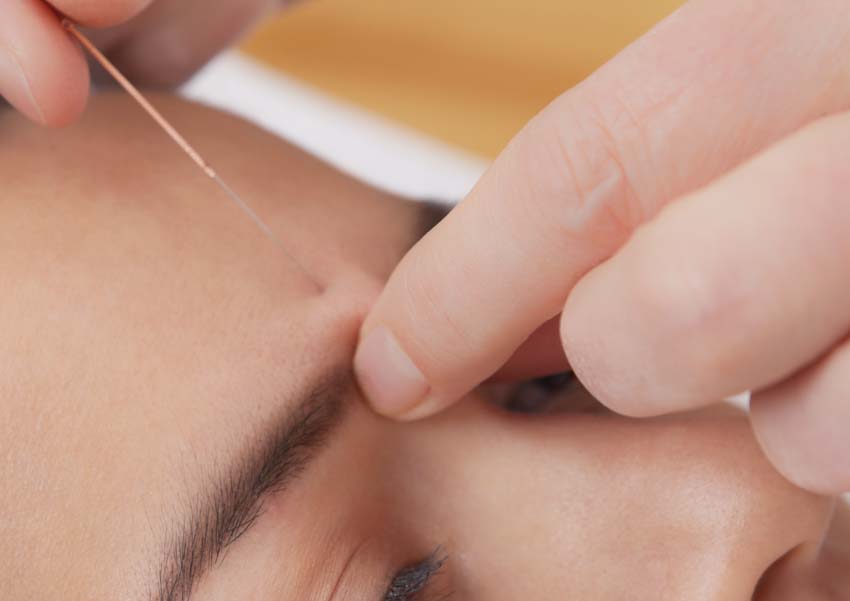
Acupuncture and herbs improve sleep for children with intractable insomnia. Kaifeng Pediatric Hospital of Traditional Chinese Medicine researchers find that the An Hun herbal formula combined with acupuncture applied to a single acupoint is effective for the relief of intractable pediatric insomnia. In a randomized controlled investigation, a total of 104 children were recruited for the study and were randomly assigned to a treatment group or a control group. The cured, markedly effective, and effective scores were added together to determine the total effective rate. In the acupuncture plus herbs treatment group, there were 20 cured, 25 markedly effective, 4 effective, and 3 ineffective cases, yielding a total effective rate of 94.2%. [1]
The treatment group was comprised of 30 male and 22 female patients, ages 3–14 years (mean age 8.6 years), with a duration of insomnia between 1–10 years (mean duration 6.8 years). The control group was comprised of 28 male and 24 female patients, ages 3–14 years (mean age 8.4 years), with a duration of insomnia between 1–9 years (mean duration 6.7 years). There were no statistically significant differences in baseline characteristics between the two groups (p>0.05).
Inclusion criteria for the study included compliance with diagnostic criteria for sleep disorders (Chinese Classification and Diagnosis of Mental Disorders, third edition), with a disease duration of over one year, and no other treatment received in the previous month. Children were required to be ages 3–14 years and informed consent was obtained from their legal guardians. Exclusion criteria included concomitant primary or congenital disease, psychiatric disorders, heart, liver, or kidney dysfunction, and allergies to any of the medications used in the study.
Acupuncture and Herbs
Participants in both groups were offered guidance in the areas of sleep hygiene, family sleep management, and diet. In addition, participants in the treatment group were prescribed the An Hun herbal formula that consisted of the following ingredients:
- Dang Shen 15g
- Chuan Xiong 15g
- Bai Shao 15g
- Fu Shen 15g
- Gou Teng 12g
- Chan Tui 12g
- Hu Po 12g
- Ban Xia 10g
- Tian Zhu Huang 6g
- Deng Xin Cao 6g
- Long Gu 20g
- Zhen Zhu Mu 20g
- Chao Bai Zhu 20g
- Gan Cao 3g
For patients with blood deficiency, Zhen Zhu Mu was omitted and Dang Gui (12g) was added. For patients with yin deficiency, Chuan Xiong and Bai Shao were omitted and Di Huang (15g) and Wu Wei Zi 10g were added. For patients with accumulation and stagnation syndrome, Ji Nei Jin (12g) was added. For patients with constipation, Yu Li Ren (12g) was added. The herbal formula was prescribed in the form of granules to be taken once daily, completely dissolved in 100–400ml of boiling water. For children ages 3 –6 years, the dosage was halved. Treatment duration was a total of one month.
Acupuncture was administered to a single acupoint: Yintang (MHN3). Needles were inserted using the skin pinching technique and were manipulated using a reducing method. Needles were rotated counterclockwise 8–10 times until resistance was met. They were then retained for 20 minutes with manipulations carried out once more during each treatment session. A total of 10 treatments were administered on non-consecutive days throughout the duration of the study. Participants in the control group were treated with psychological behavioral intervention and prescribed Xiao Er Zhili (Children’s Intellect) syrup, a proprietary medicine containing Gui Jia, Long Gu, Yuan Zhi, Shi Chang Pu, and Xiong Ji. Participants in the control group did not receive acupuncture or the An Hun herbal formula.
Outcomes and Discussion
The primary outcome measure for the study was the CSHQ (Children’s Sleep Habits Questionnaire), a 22-item scale covering the areas of bedtime, sleep behavior, waking during the night, and morning wake-up routine. Each item was graded from 1–3 points, with deleterious habits occurring 0–1 time weekly awarded one point, those occurring 2–4 times weekly with two points, and those occurring 5–7 times weekly with three points. Lower scores indicate greater improvements.
At baseline, mean CSHQ scores were 64.56 in the treatment group and 64.04 in the control group. After one month of treatment, scores fell significantly to 43.75 and 53.38 respectively (p<0.05). At the three-month follow-up, CSHQ scores were 43.85 and 53.56 respectively, showing no statistically significant change from the one-month mark (p>0.05).
TCM efficacy scores were calculated for the two groups. For patients with a complete resolution of symptoms, a CSHQ score of <54 and no recurrence of symptoms within the three-month study period were classified as cured. For those with a complete resolution of symptoms and a CSHQ score of <54, but some minor recurrence of symptoms within three months, treatment was classified as markedly effective. For those with an obvious improvement in symptoms such as prolonged sleep time and enhanced quality, but had a CSHQ score of >54 and more frequent recurrence of symptoms within three months, treatment was classified as effective. For those showing no improvement or an aggravation of symptoms, treatment was classified as ineffective.
The cured, markedly effective, and effective scores were added to give the total effective rates. In the treatment group, there were 20 cured, 25 markedly effective, 4 effective, and 3 ineffective cases, yielding a total effective rate of 94.2%. In the control group, there were 8 cured, 15 markedly effective, 18 effective, and 11 ineffective cases, yielding a total effective rate of 78.9%. The results indicate significantly greater improvements in the acupuncture and herbal medicine treatment group (p<0.05).
The results of this study indicate that a combined protocol of acupuncture and herbs provide effective relief from intractable insomnia in children. The use of a single acupoint proved effective, making this treatment suitable for young children that may have difficulty sitting still.
Reference:
1. Zhu Bao (2018) “Clinical research on acupuncture combined with traditional Chinese medicine for children with intractable sleep disorders” Chinese Integrative Medicine Pediatrics Vol. 10 (5) pp. 400-403.


